Images

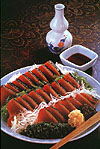









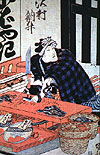



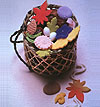

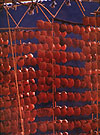



|
2. Renewal
The Japanese are highly sensitive to seasonal changes and endeavor to add rhythm to their lives throughout the year by marketing certain nodes in time.
Food plays a large role in providing seasonal accents. At the same time, seasonal foods have nurtured the cultural habit of appreciating the freshness of what is in season.
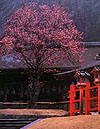 The obsession with seasonal food is epitomized in the old Japanese saying, "pawning off one's wife is a small price to pay for a fresh bonito". This is a joke, of course.
The obsession with seasonal food is epitomized in the old Japanese saying, "pawning off one's wife is a small price to pay for a fresh bonito". This is a joke, of course.
No wife today would stand for that. Rather it's the husband who is making the sacrifices nowadays.
Spring time.
Flowers in full bloom fill the air with happiness and joy. What better way to celebrate the coming of spring than an outdoor party under the resplendent shade of cherry blossoms.
The picnic lunch for cherry-blossom-viewing party comes in a thin, wooden disposable box. Beautifully packed, it's a feast for the eyes as well.
In the old days, gorgeously lacquered picnic containers like this was used to enhance the festive mood.

When the blossoms drop, fresh leaves begin to grow. This is a sweet bean cake wrapped in an aromatic cherry leaf, which can also be eaten. The light, translucent flavor tickles the palate with spring.
Steamed red snapper sushi is the spring time feast. The small basket steamer itself becomes a convenient package.
Early summer.
The radiant fresh green is striking to the eye.
A sweet fish, ayu, looks fresh and tasty in this portable bamboo container.
Summer.
Japanese summer is unbearably hot and humid. Unable to escape the heat, people seek for coolness at least in visual terms.
Cool to the tongue, this is a popular summer dessert. Liquefied sweet bean is poured into a bamboo tube and sealed with bamboo grass.
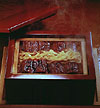 Even in the summer heat, this broiled eel dish is sure to stir one's appetite. Eel, in Japan, is considered an energizer.
Even in the summer heat, this broiled eel dish is sure to stir one's appetite. Eel, in Japan, is considered an energizer.
 Green bamboo also serves as a dish. We have a so-called "Eel's day" in mid-August, when people are reminded to shore up their stamina by eating eel.
Green bamboo also serves as a dish. We have a so-called "Eel's day" in mid-August, when people are reminded to shore up their stamina by eating eel.
Delicate noodles placed in a white ceder basket. It's a visibly cool package.
 Autumn.
Autumn.
All living things are invigorated by the cool autumn breeze.
Autumn flavor is epitomized in the matsutake mushrooms. The highly aromatic mushrooms are placed in a basket laid with deep green fir leaves.
It's the epicurean food for flavor-sensitive Japanese. But, like truffles, the matsutake mushrooms cost an arm and a leg.
Dried confectionery reflecting the colorful autumn ferriage.
 Collected in a bamboo basket, the miniature autumn leaves unfold the drama of the season.
Collected in a bamboo basket, the miniature autumn leaves unfold the drama of the season.
Autumn is also the harvest season.
In a festive mood, a fresh rice plant decorates the elaborate hairdo of maiko.
The remaining rice husks are used as packing for shipping autumn fruits. There's no part to waste on a rice plant.

In preparation for the winter season, semi-dry foods like dried persimmon, bean cake and fish are hung in a neat row under the eaves.

Winter.
Shivering against the cold, people take refuge in a hot bottle of sake and fish in season like yellow tail and salmon.
Fresh salted fish is wrapped in straw and transported throughout Japan.
Salmon and trout roe, soaked in salt water, is placed in a ceramic pot wrapped with straw.
   
Think Visually, Act Graphically!
|